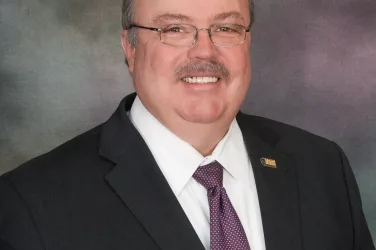
Q&A
Neurosurgeon
The pain in my neck is interfering with my daily life. Could it be Cervical Myelopathy?
Cervical Myelopathy is a condition that goes beyond a simple morning-time crick in your neck. Chronic neck pain can make daily life challenging and reduce your overall quality of life. The vertebrae of our cervical spine are vulnerable, with four separate joints in each vertebra that help them move (two facet joints and two unconvertable joints). The intervertebral discs provide cushioning between these vertebrae. Ligaments and tendons provide stability to the spinal column.
As we age, our intervertebral discs naturally begin to flatten and lose their supportive bounce. Ligaments loosen and lengthen and may struggle to recover from overuse, strain, or injury. Cervical myelopathy (also called cervical spondylotic myelopathy or spinal cord compression) is compression of the spinal cord in the neck due to this wear and tear that occurs as we age.
What are some of the symptoms?
The compression that causes Cervical Myelopathy can lead to symptoms that include difficulty grasping objects, tingling, numbness, or weakness in the hands and arms, difficulty walking (not dizziness but an inability to coordinate the body), stiffness in the neck, and fewer fine motor skills. As the condition progresses, pain may radiate down the arms, across the shoulders, and into the upper back.
What can you do to help me?
We always begin with the least invasive treatments such as diet, exercise, and physical therapy before considering surgery. Many patients experience pain relief and increased mobility with these non-invasive treatments. Once all non-surgical options have been explored, there are a number of surgical approaches to Cervical Myelopathy. These include spinal fusion, spinal-cord decompression surgery, and anterior cervical discectomy and fusion. There’s no need for you to suffer. We’ll partner with you to find the treatment that provides the best likelihood of pain relief, today and going forward.
I suspect I might be suffering from sciatica. How can I be sure?
Many people who suffer from back pain refer to their pain as sciatica. However, sciatica is actually a specific type of back and leg pain that can be incorrectly labeled as the root cause of back pain. Sciatica is defined by a very specific set of symptoms. The most common symptoms are weakness, numbness in the leg or foot, “pins and needles” anywhere along the nerve path, burning pain, stabbing pain that worsens when you sneeze or cough, shooting pain that makes prolonged sitting or standing impossible, and radiating pain that originates from the lumbar spine. And you’ll typically only feel sciatica symptoms on one side of your body.
How can you help?
Again, we want to begin with lifestyle changes such as exercise, smoking secession, and dietary interventions as well as physical therapy. Only after we’ve exhausted these non-surgical options would we discuss surgical intervention such as spinal-cord decompression, posterior lumbar interbody fusion, or lumbar laminectomy with nerve root decompression. Sciatica pain can be debilitating, creating painful challenges in everyday life. But there is much a qualified neurosurgeon can do to help you find relief.
About The Expert

Jacob Rosenstein, MD, FAAN, FACS
North Texas Neurosurgical Consultants
Board-Certified Neurosurgeon Jacob Rosenstein has been a leader in his medical field since 1985. Specializing in the diagnosis and treatment of spine related disorders, Dr. Rosenstein treats patients suffering from conditions ranging from simple sprains to complex spine disorders. Specializing in cervical and lumbar spine problems, he performs a wide variety of procedures ranging from spinal injections to complex spine surgery. He specializes in cervical and lumbar stenosis and can treat these conditions with various techniques including minimally invasive spine surgery as well as fusion if necessary.










